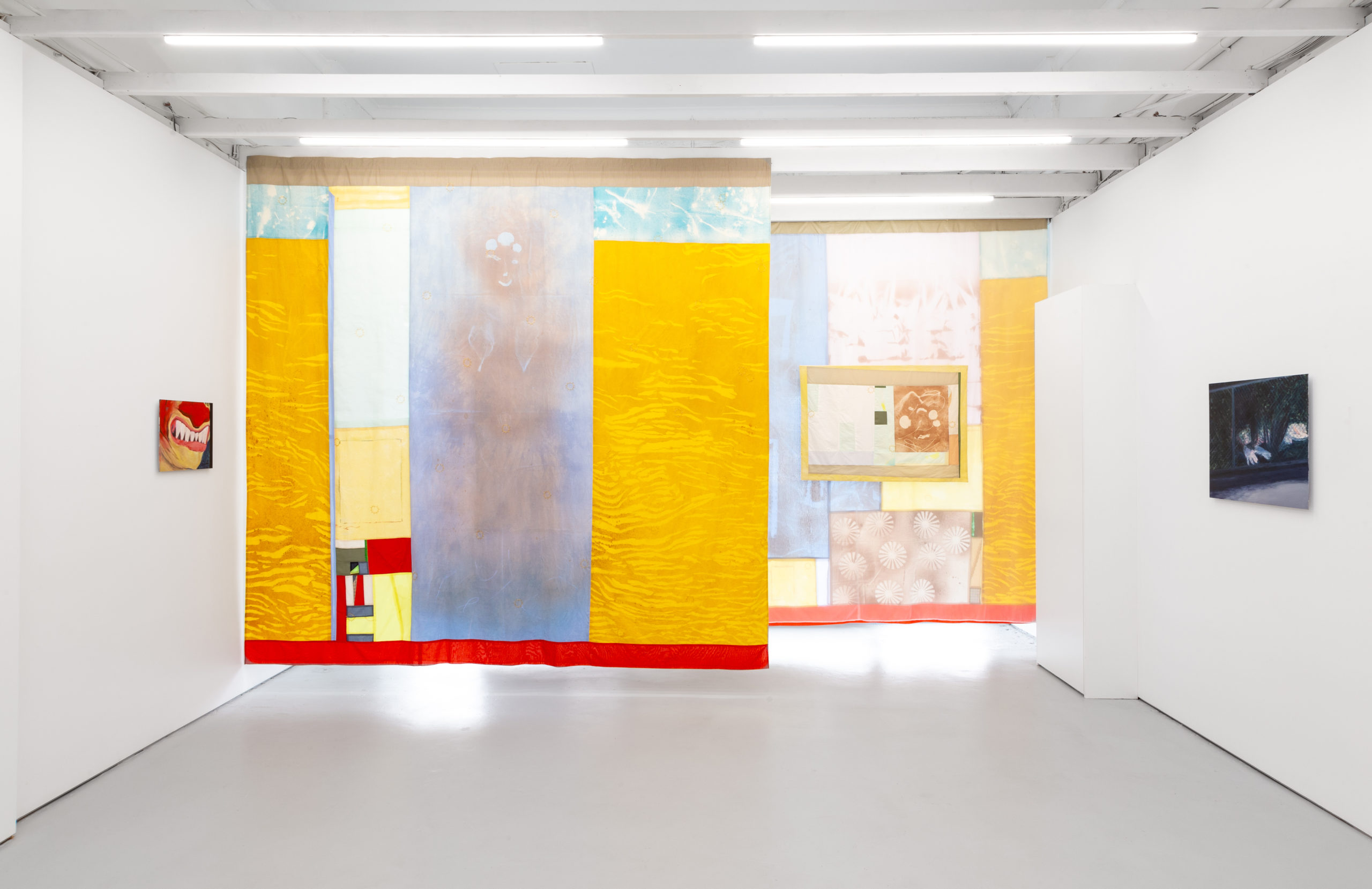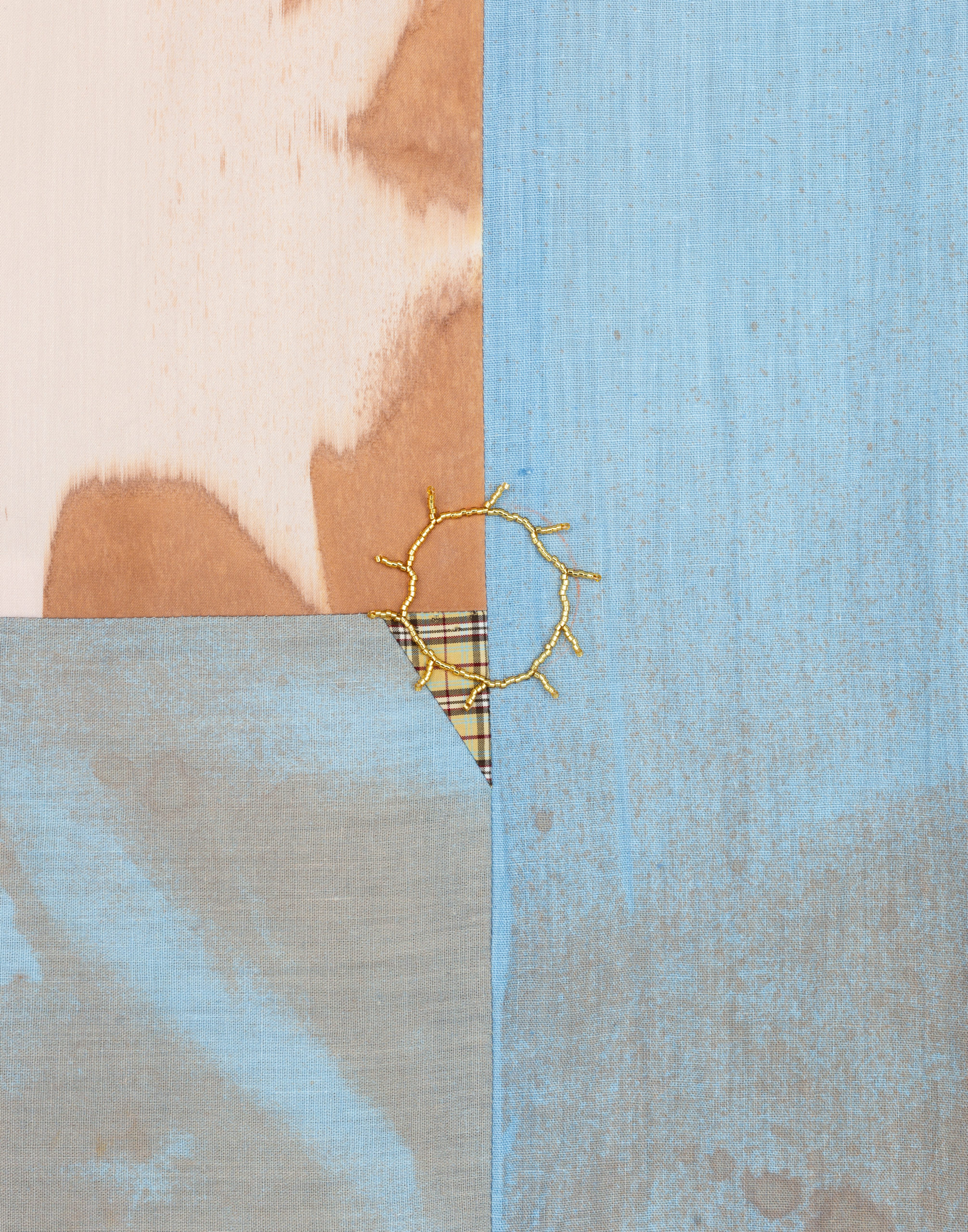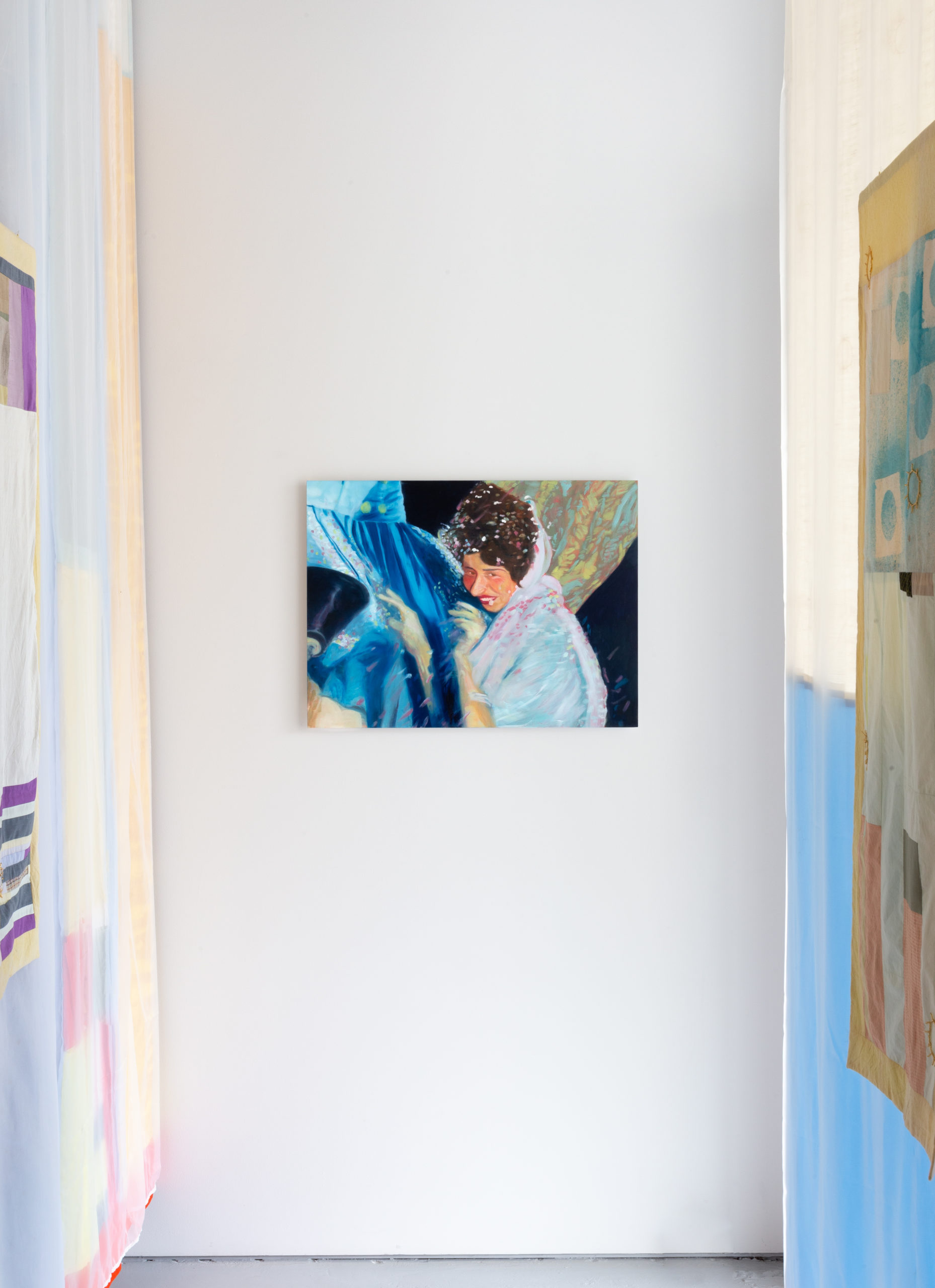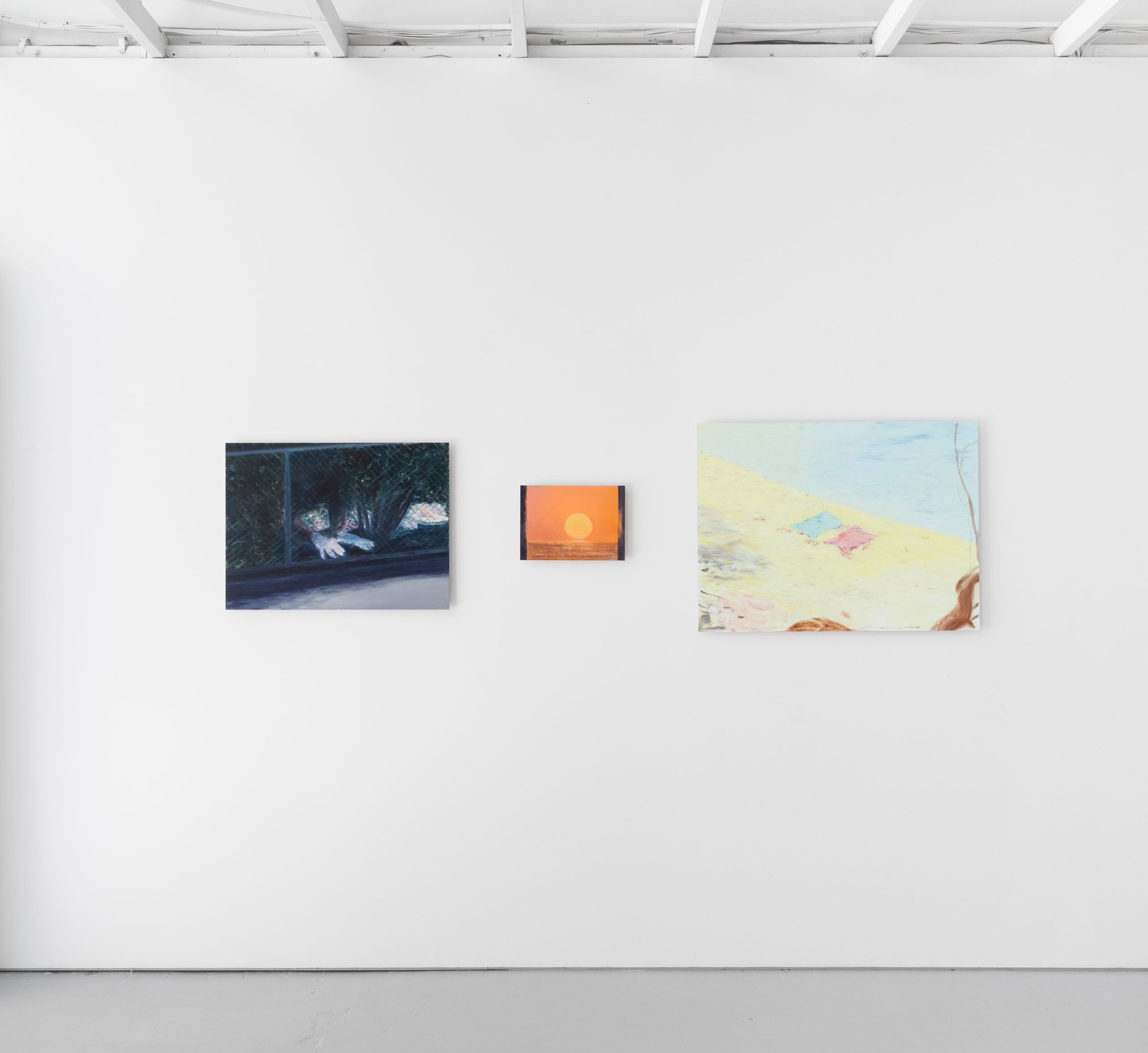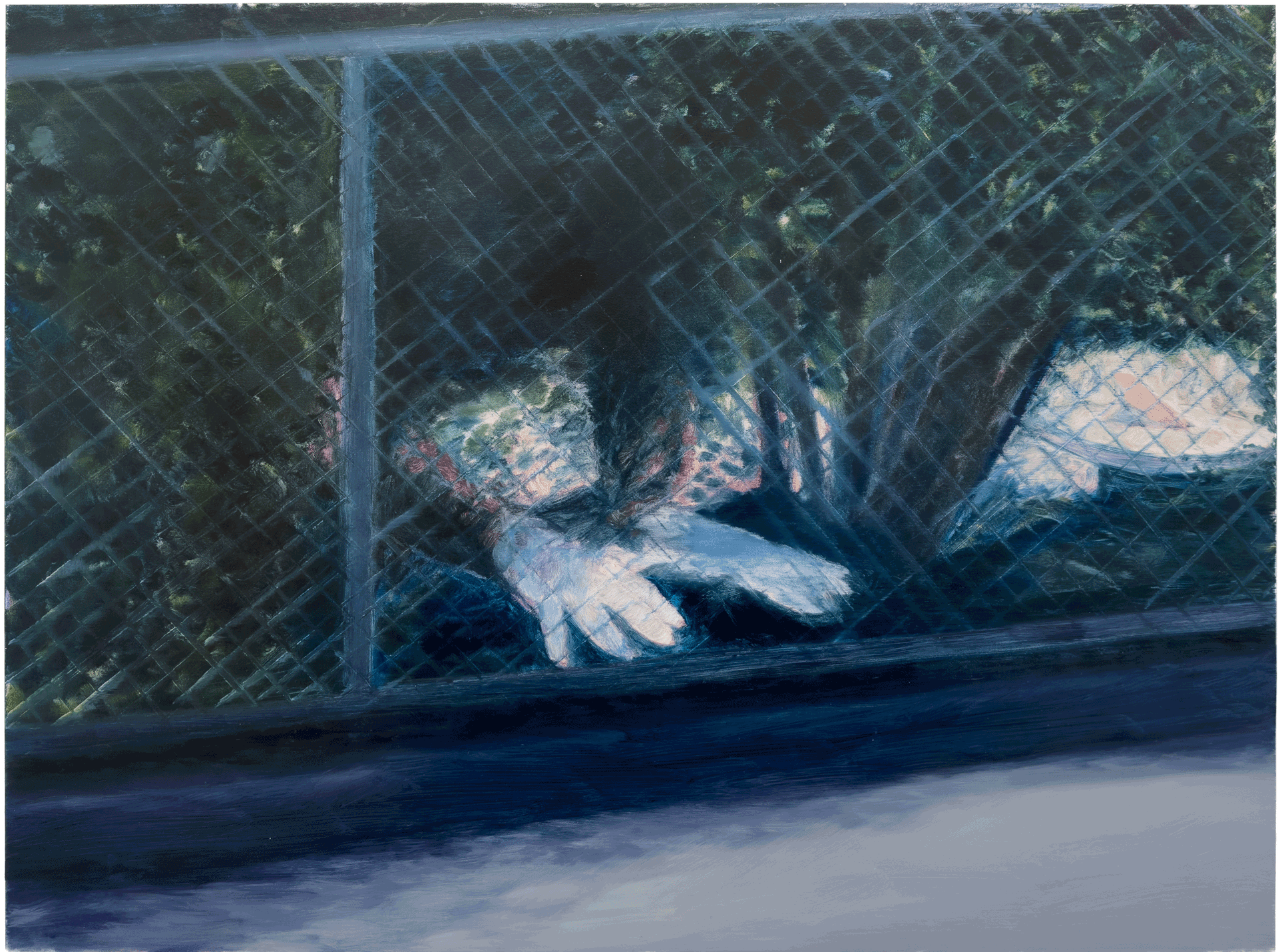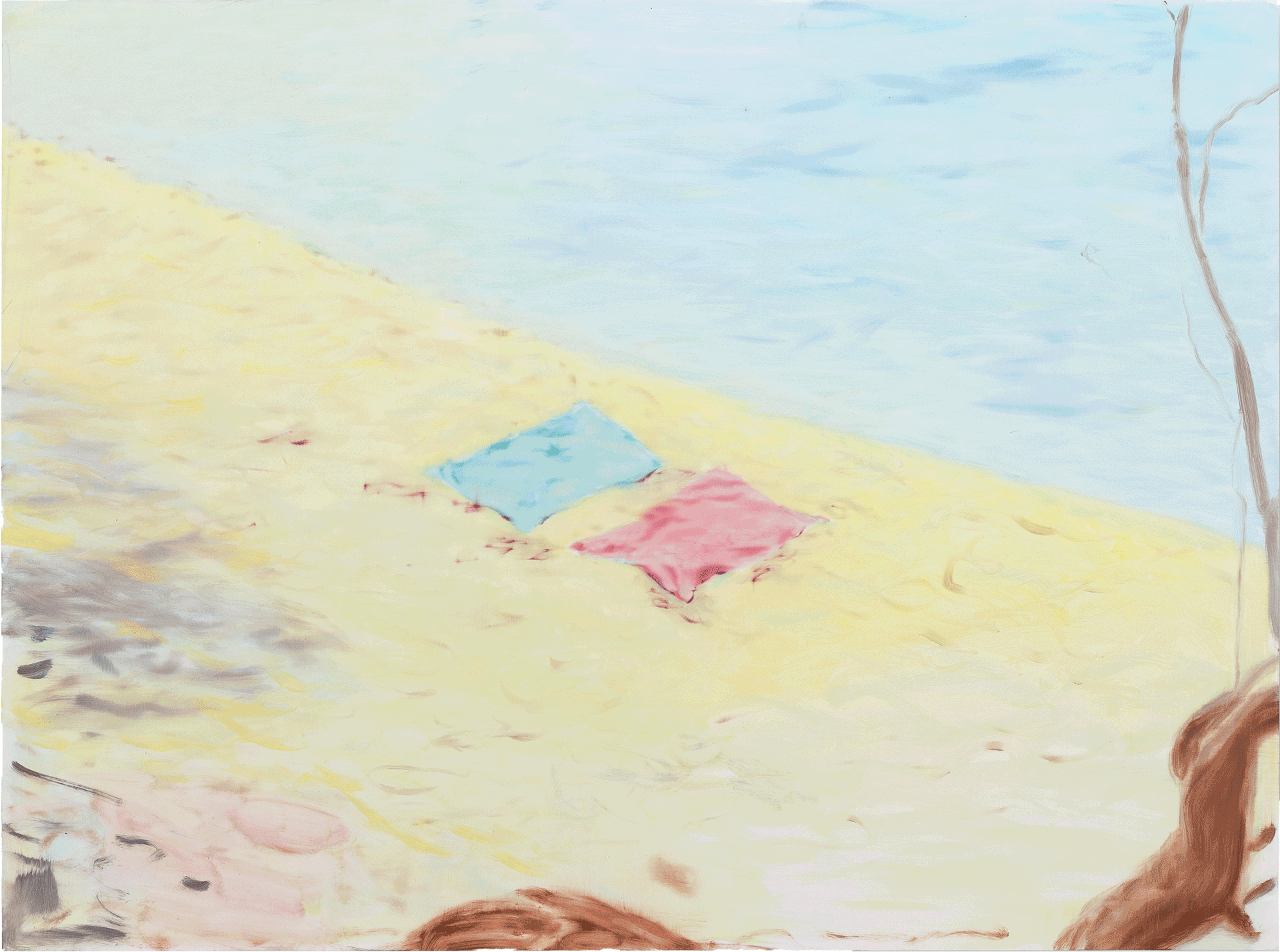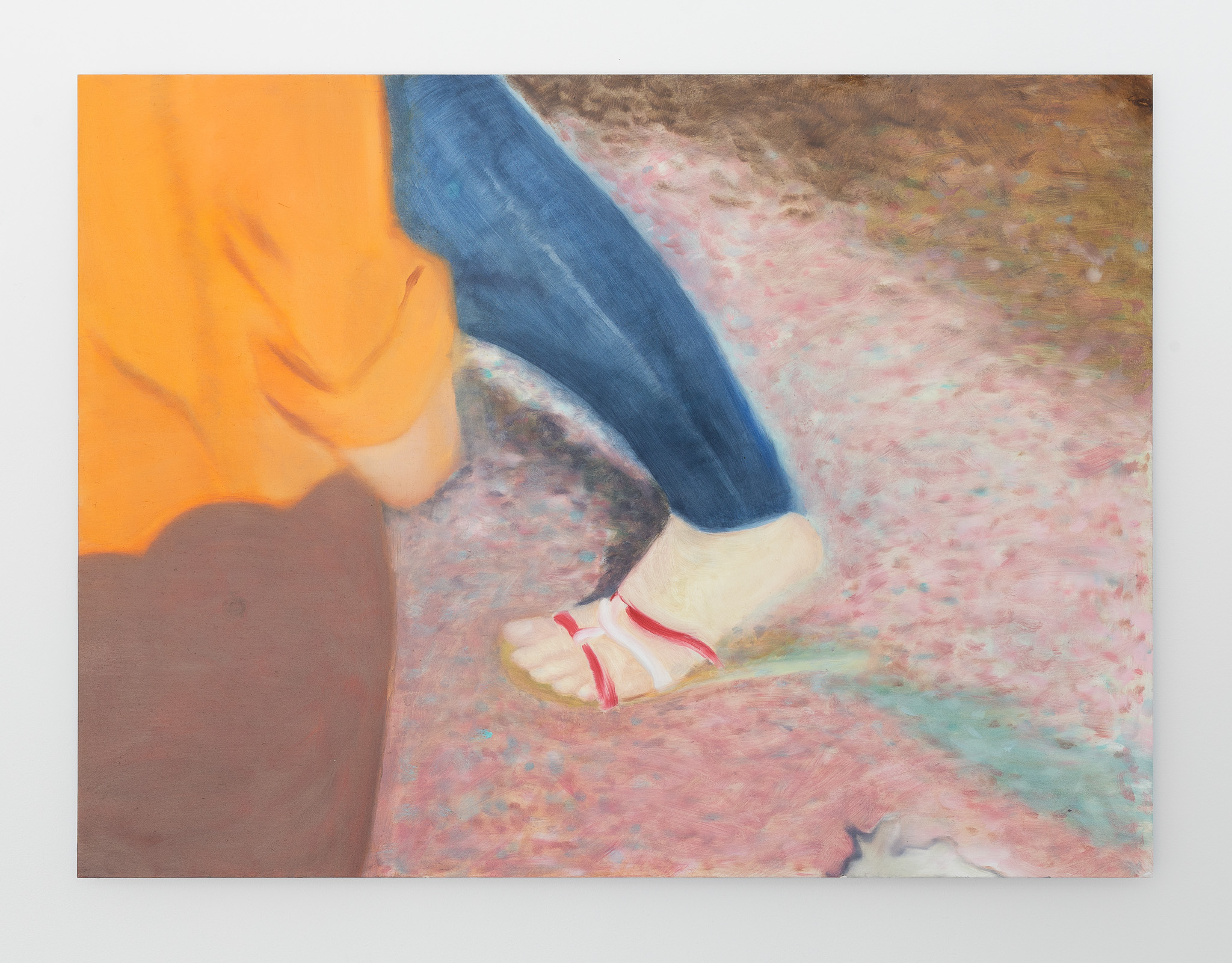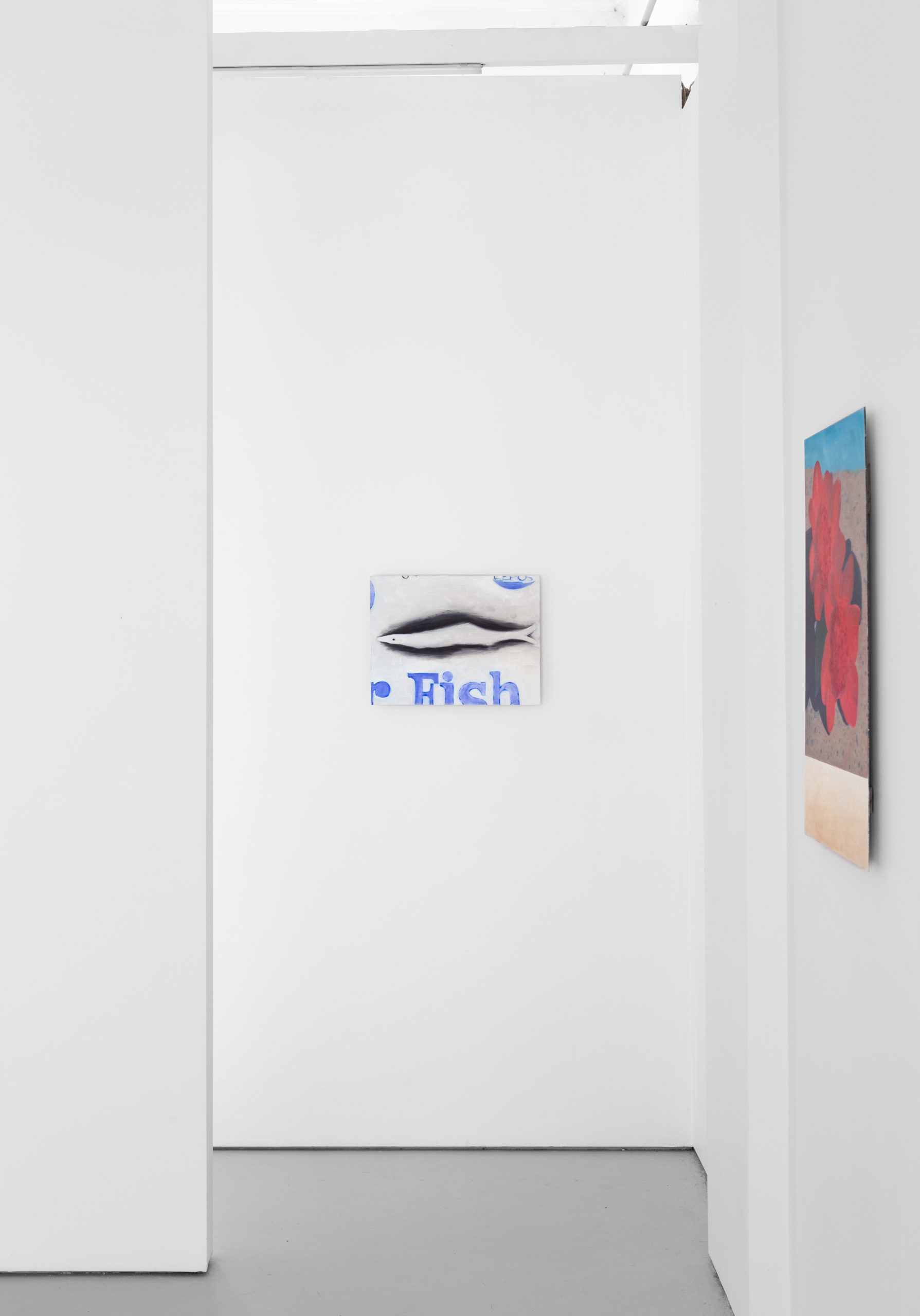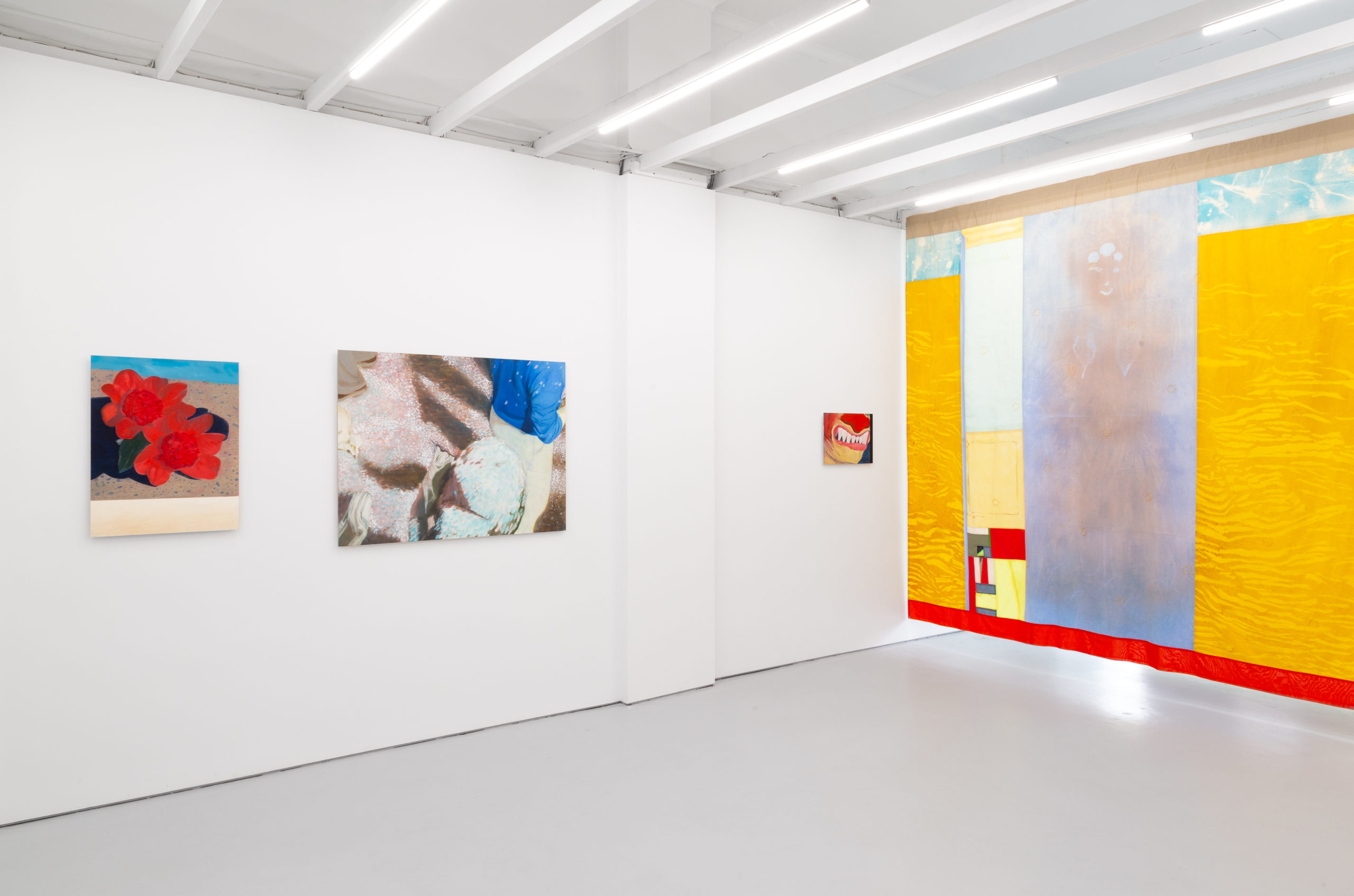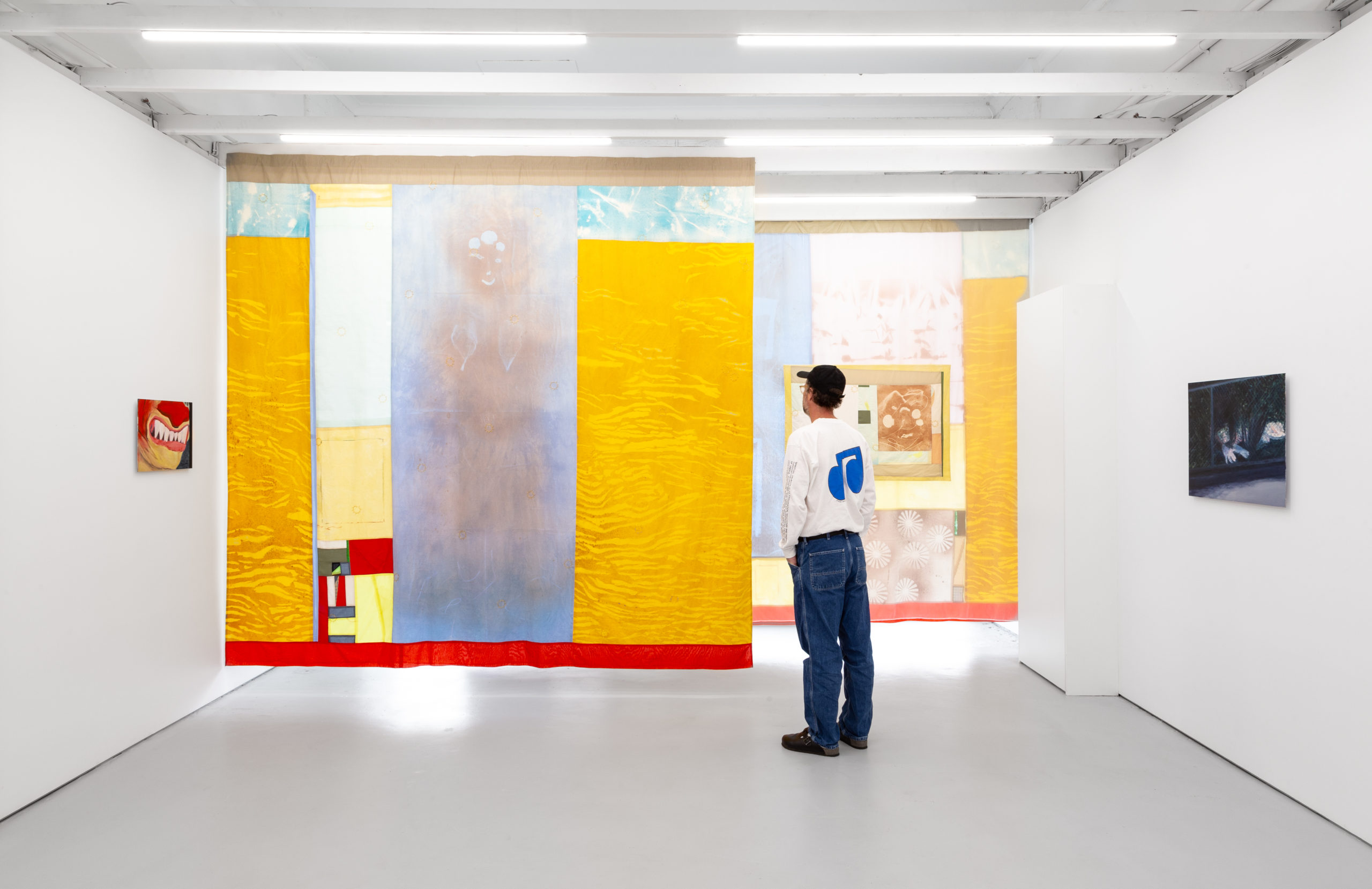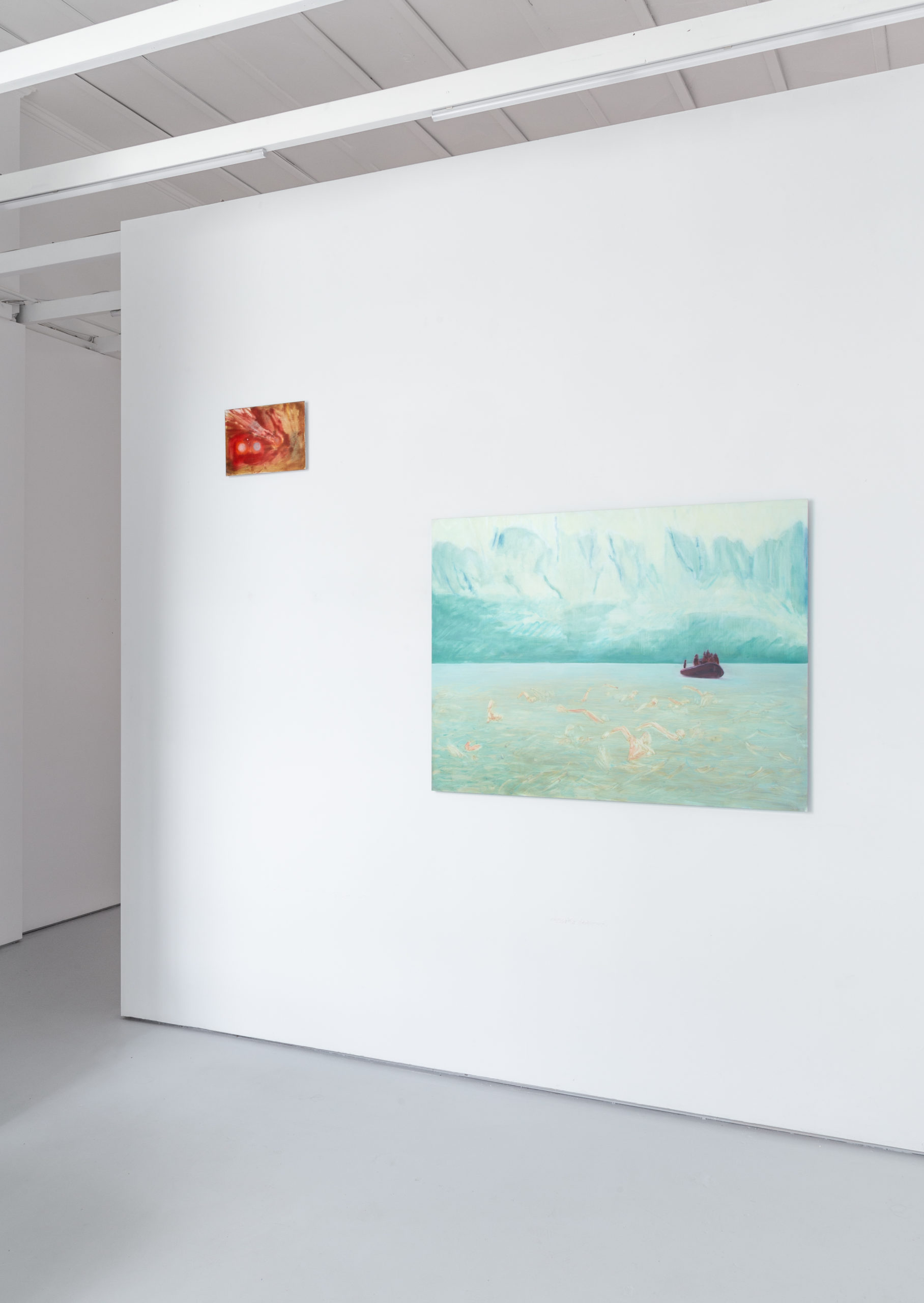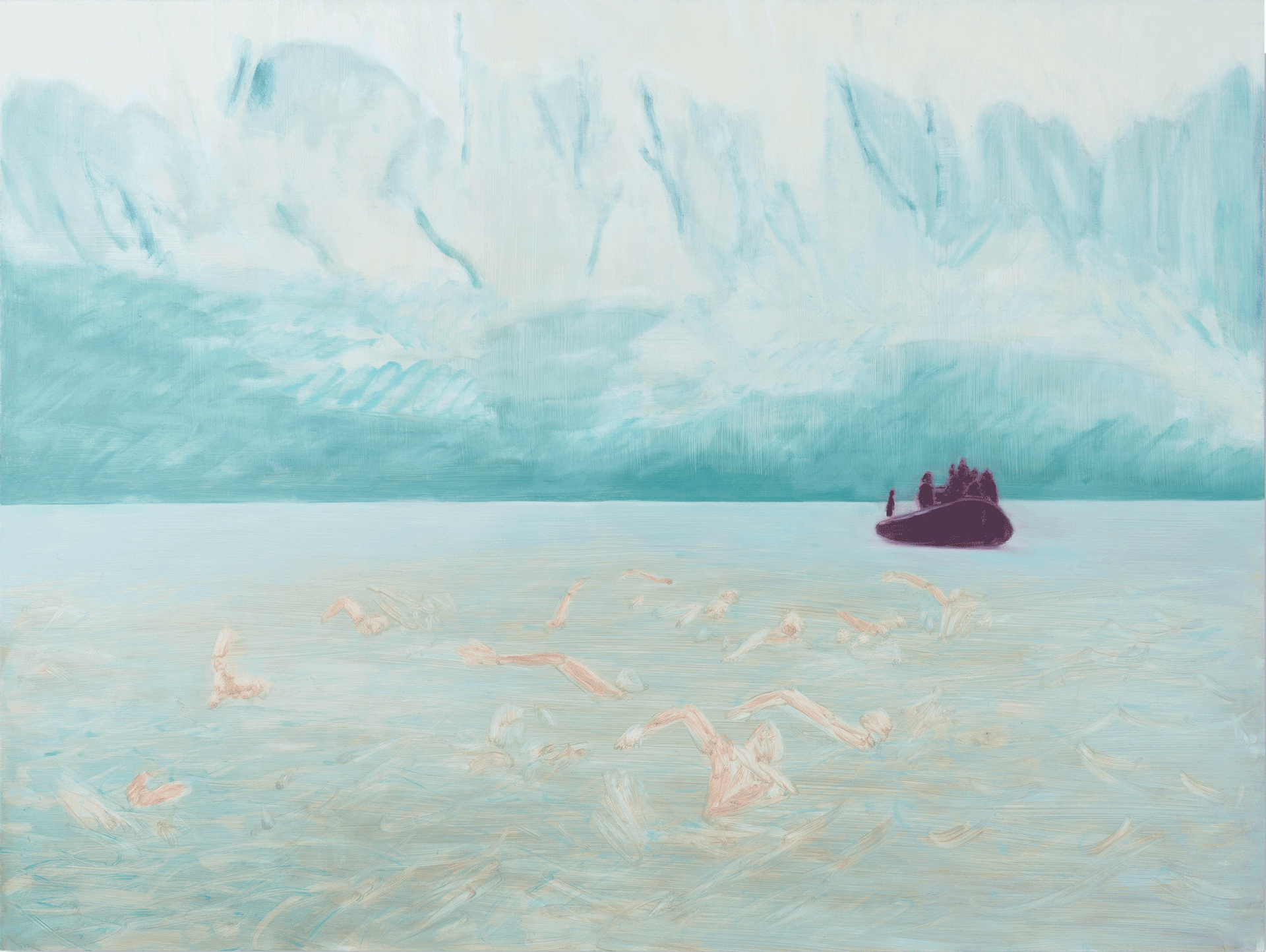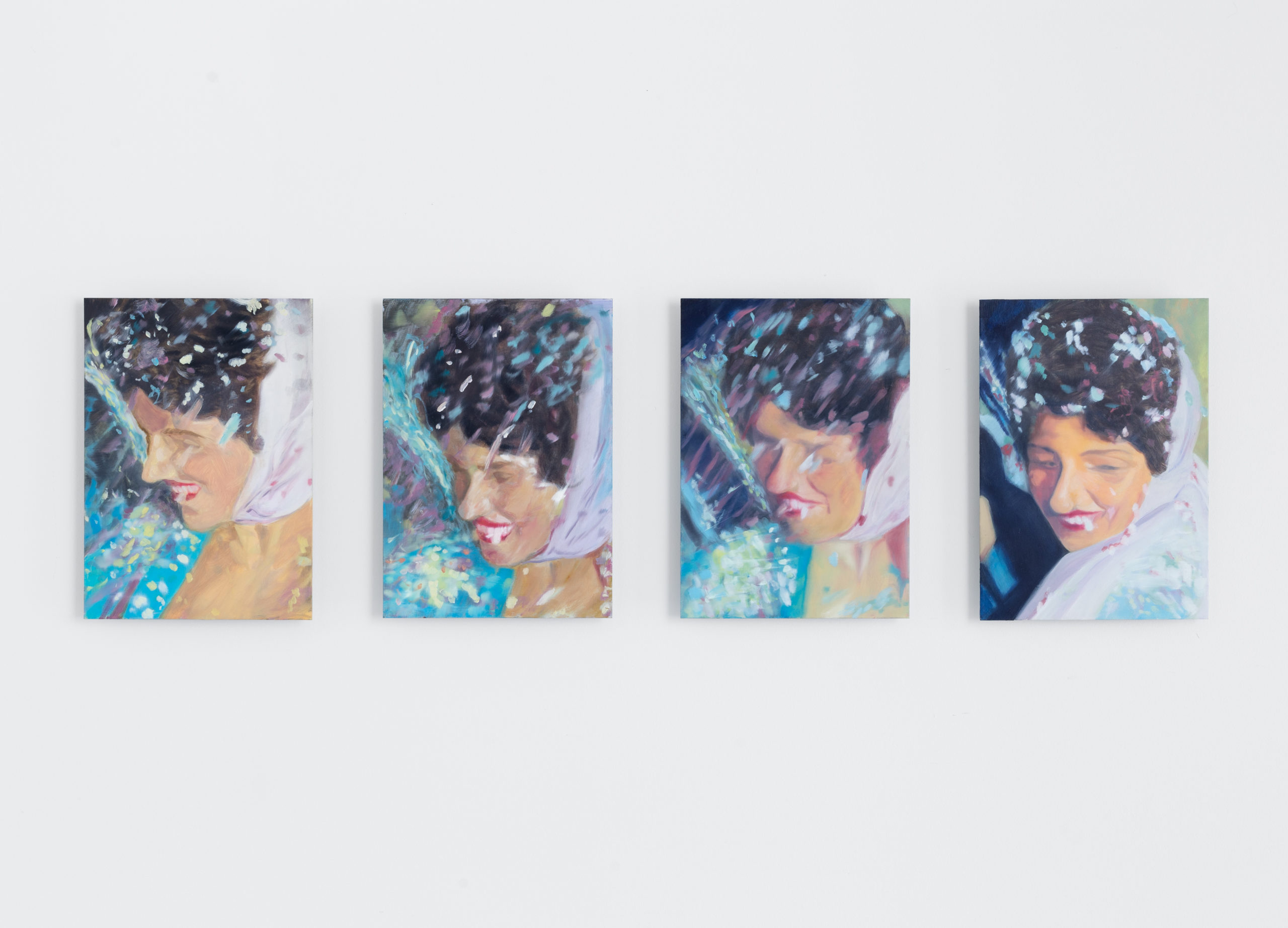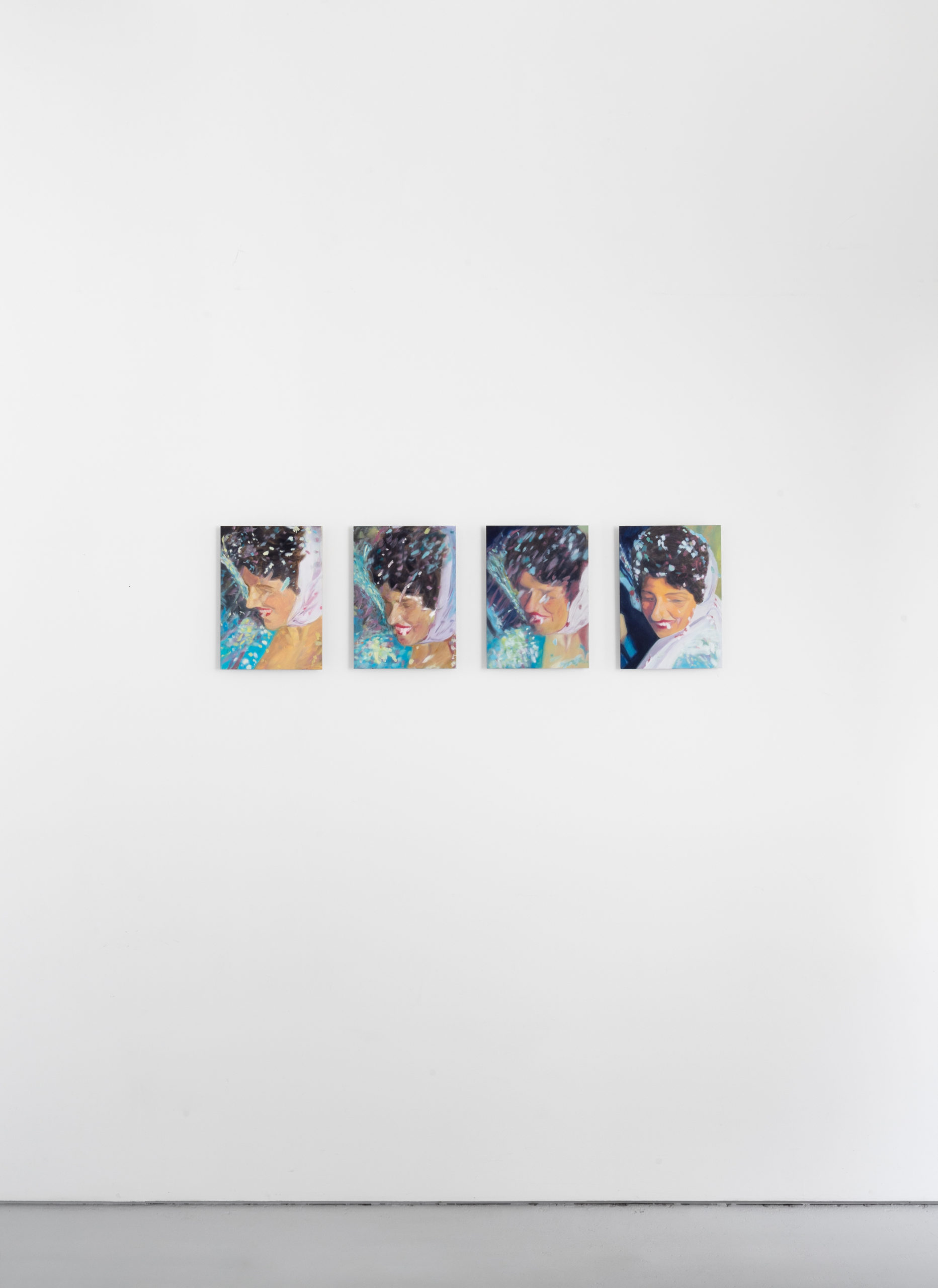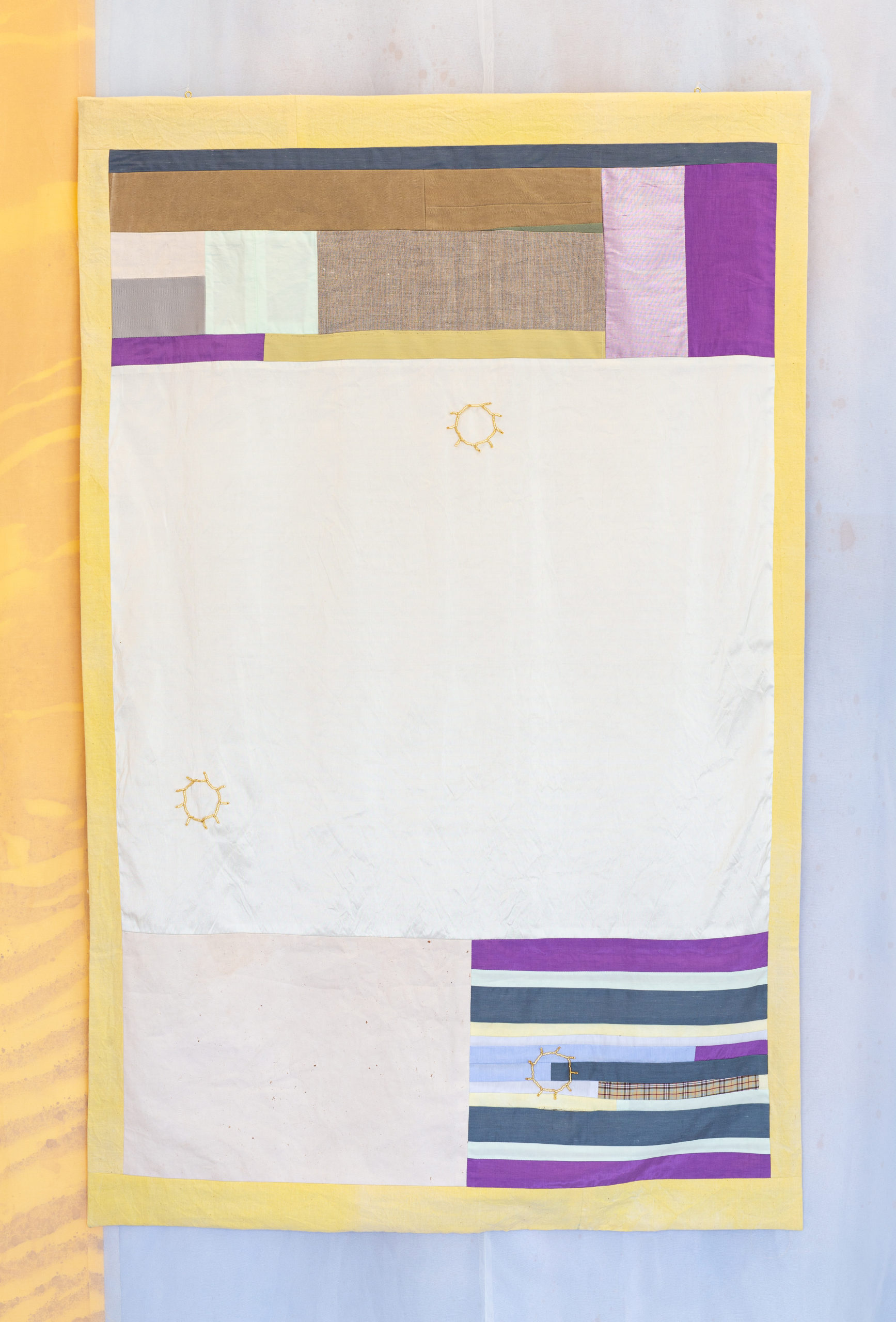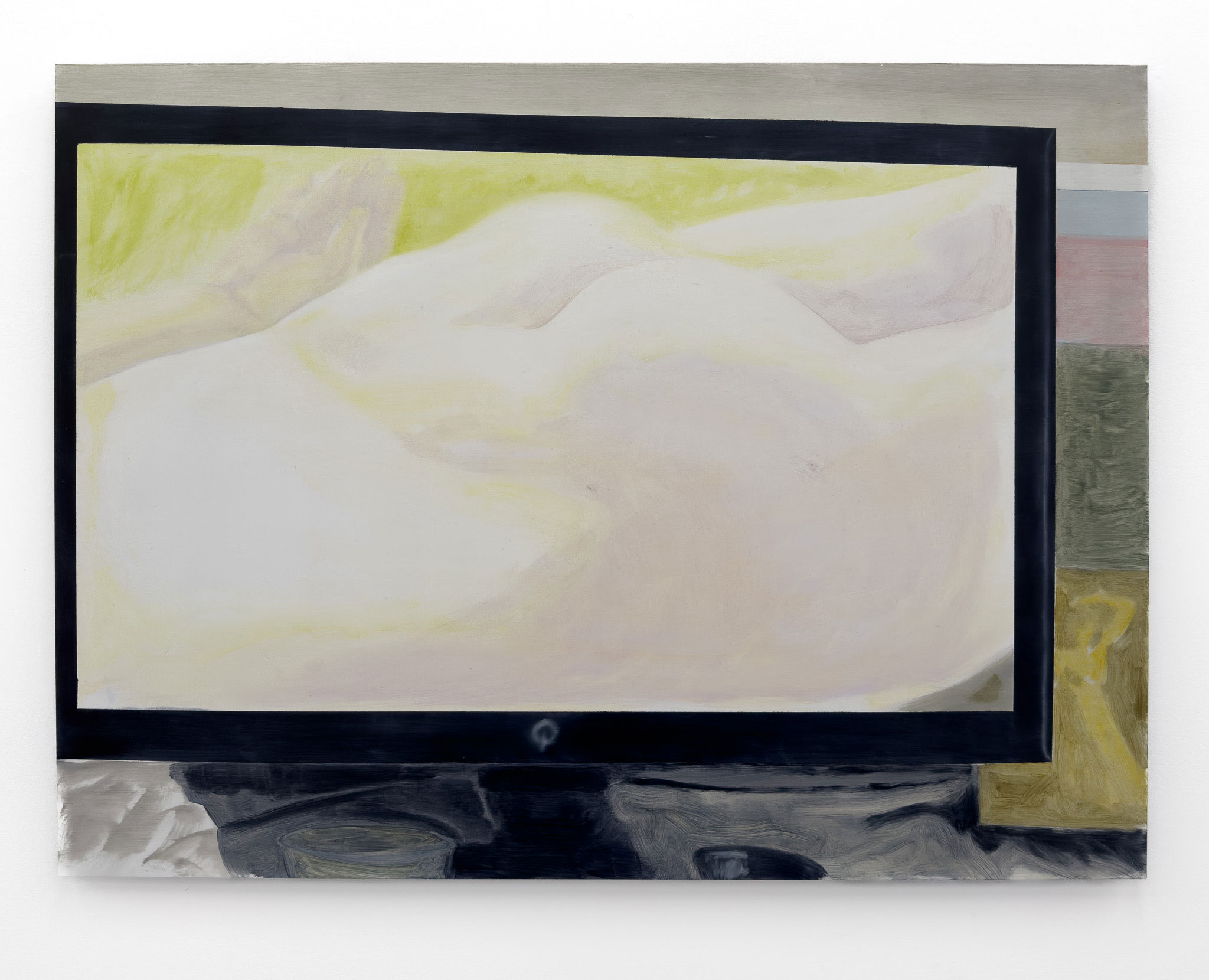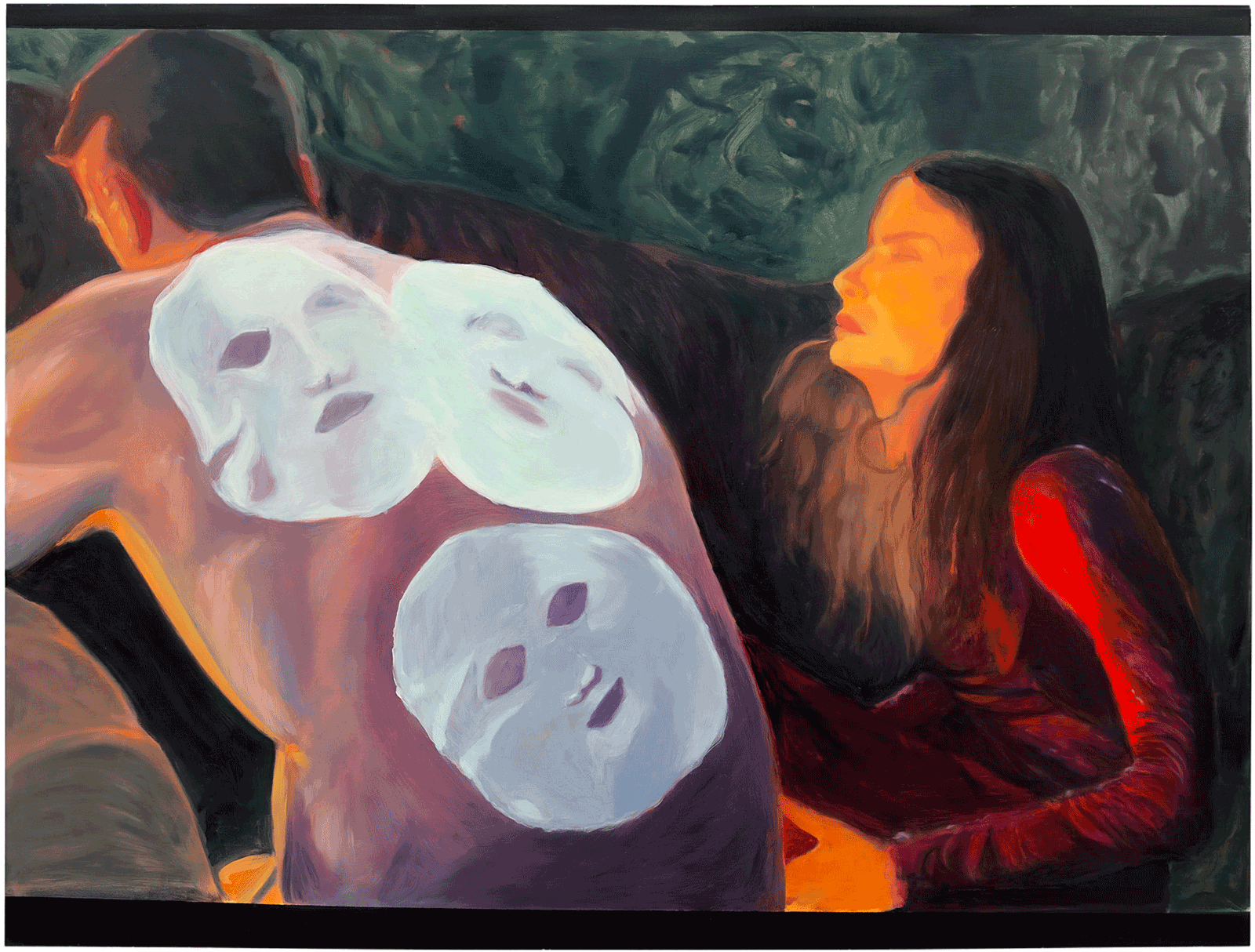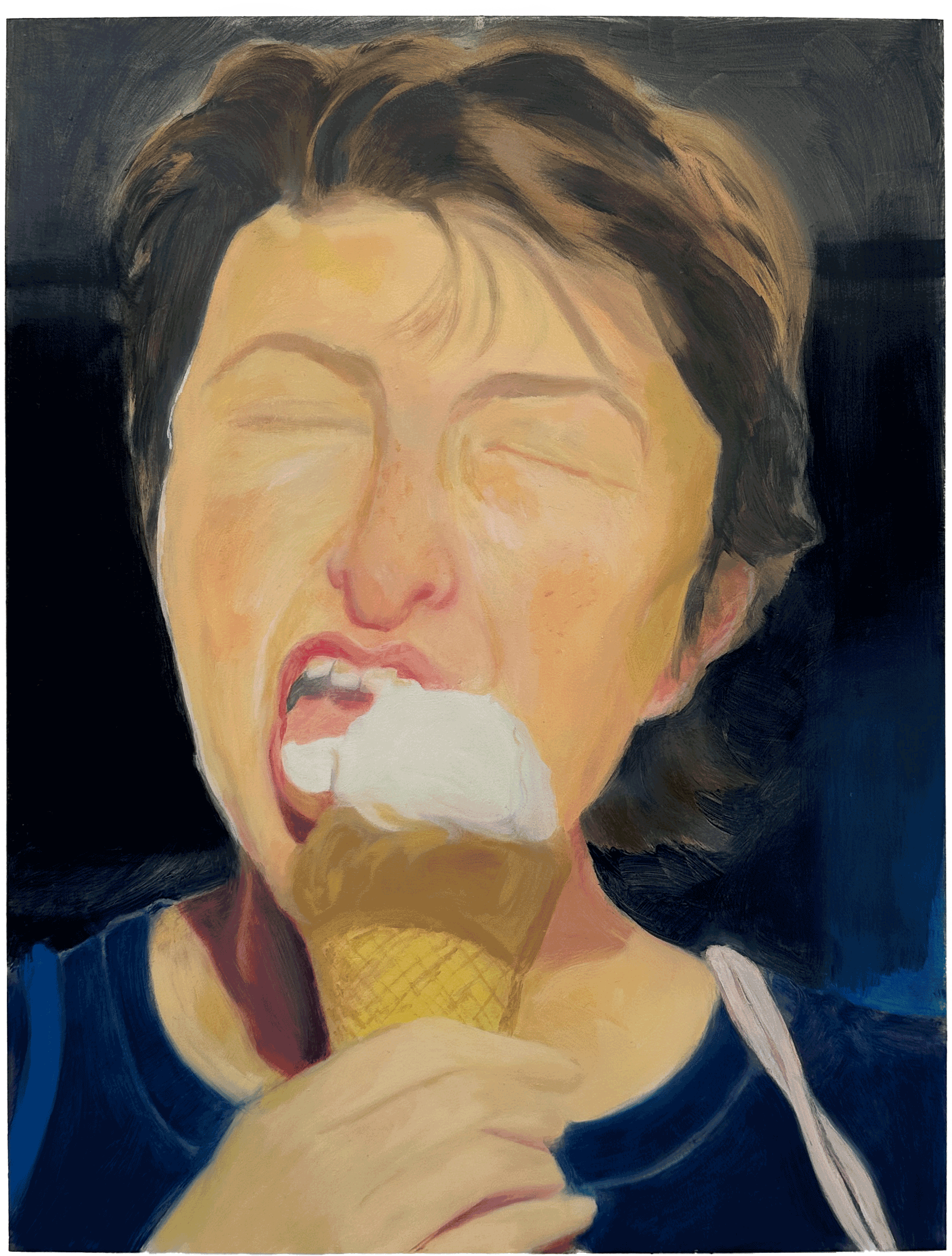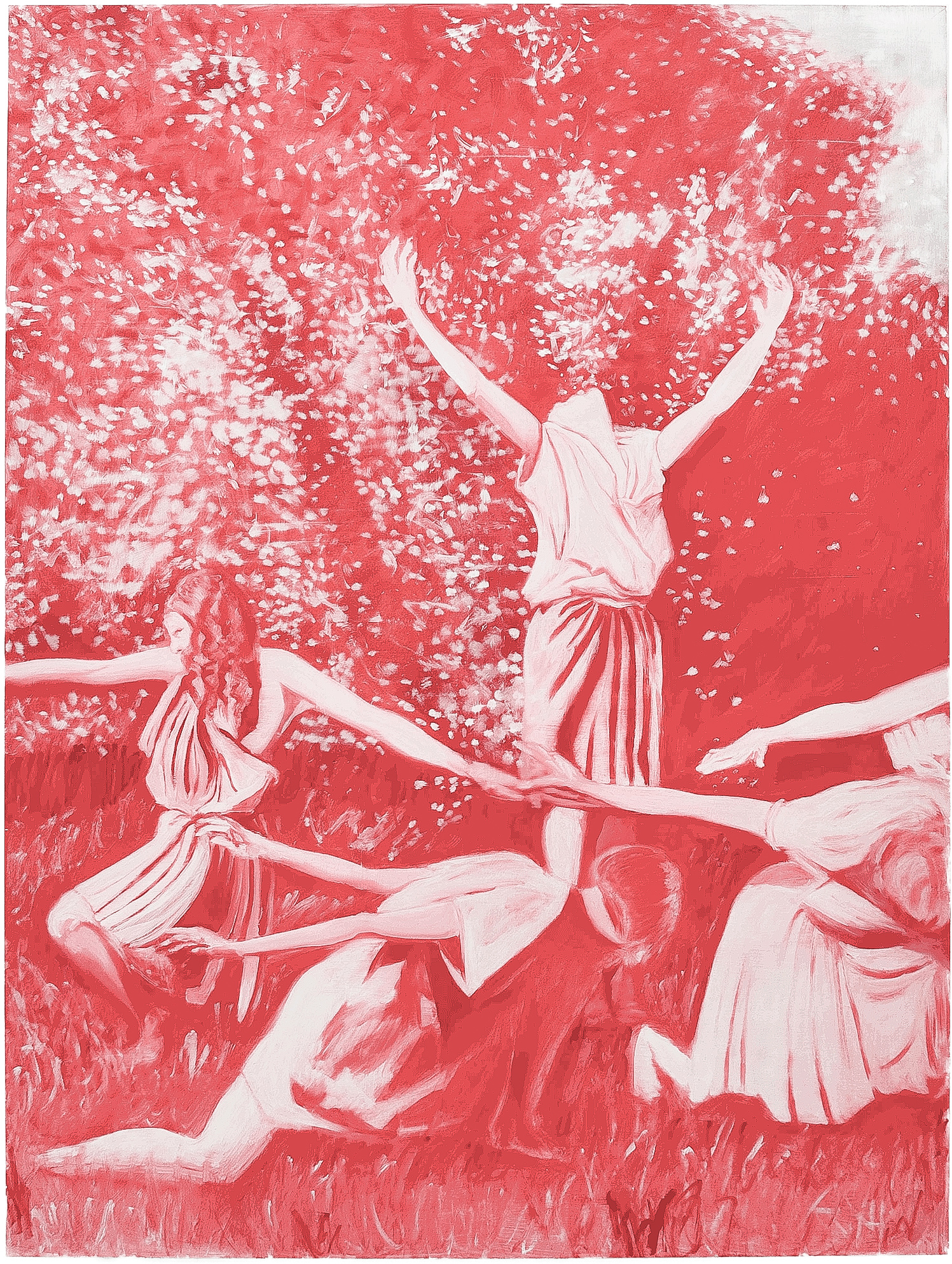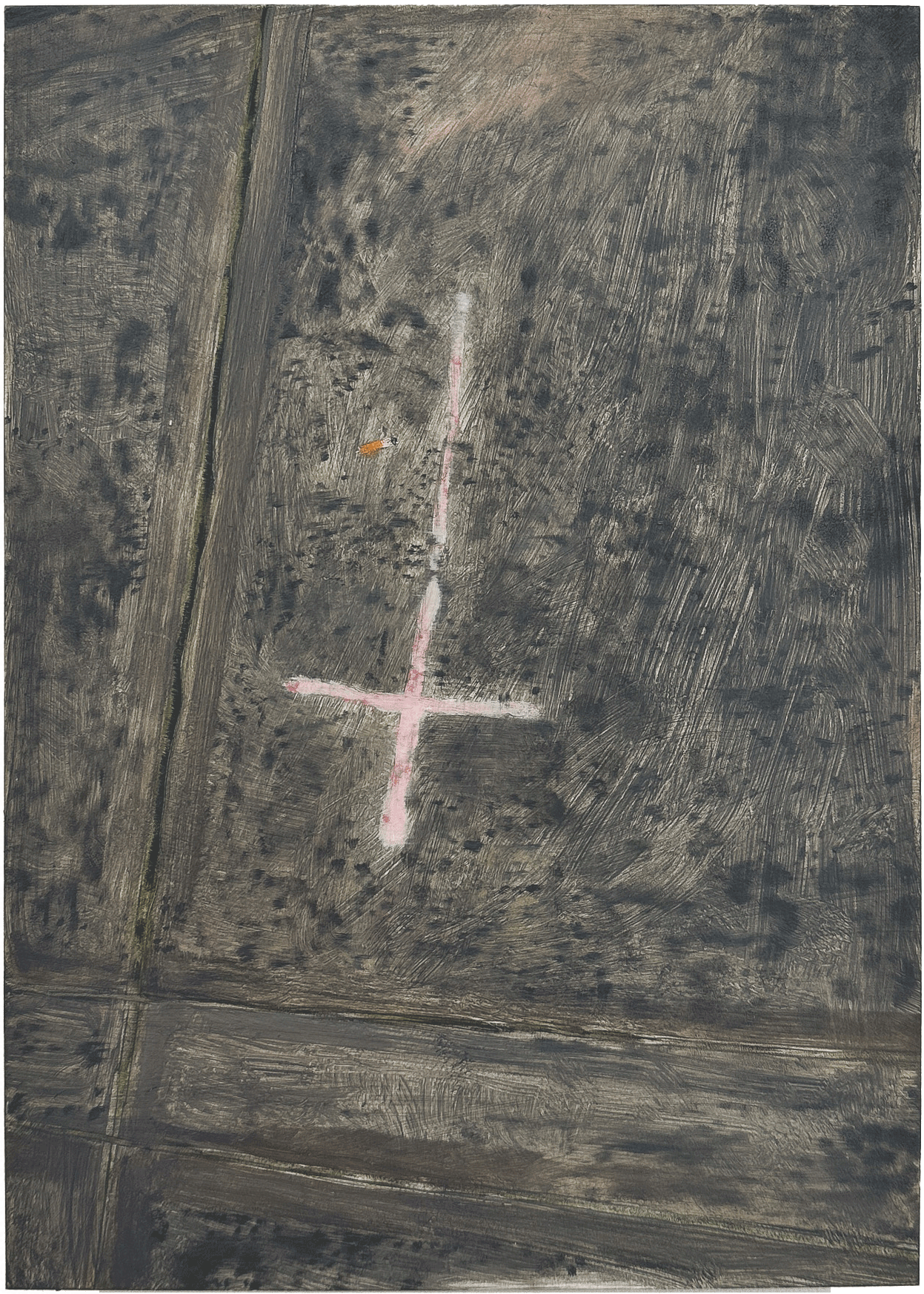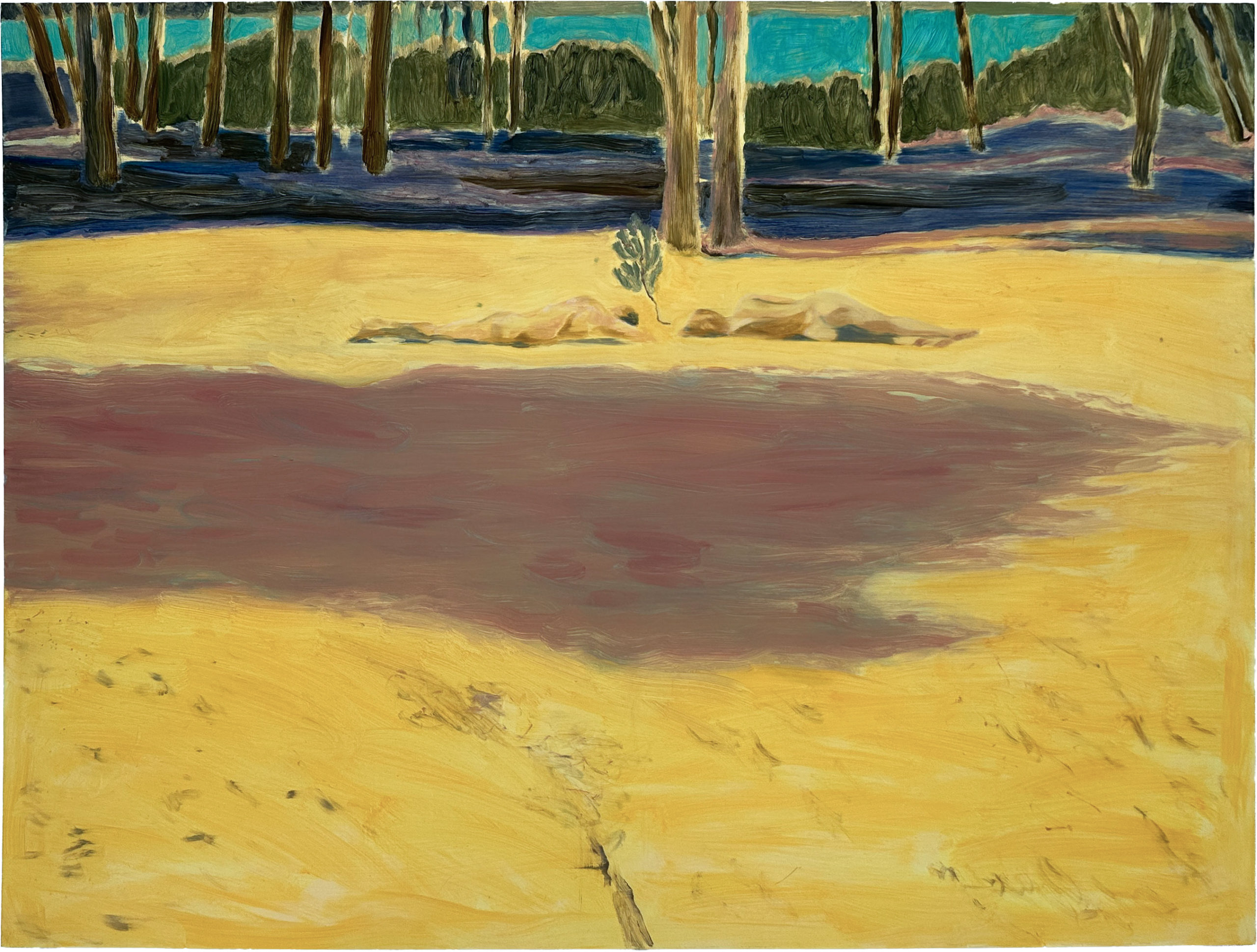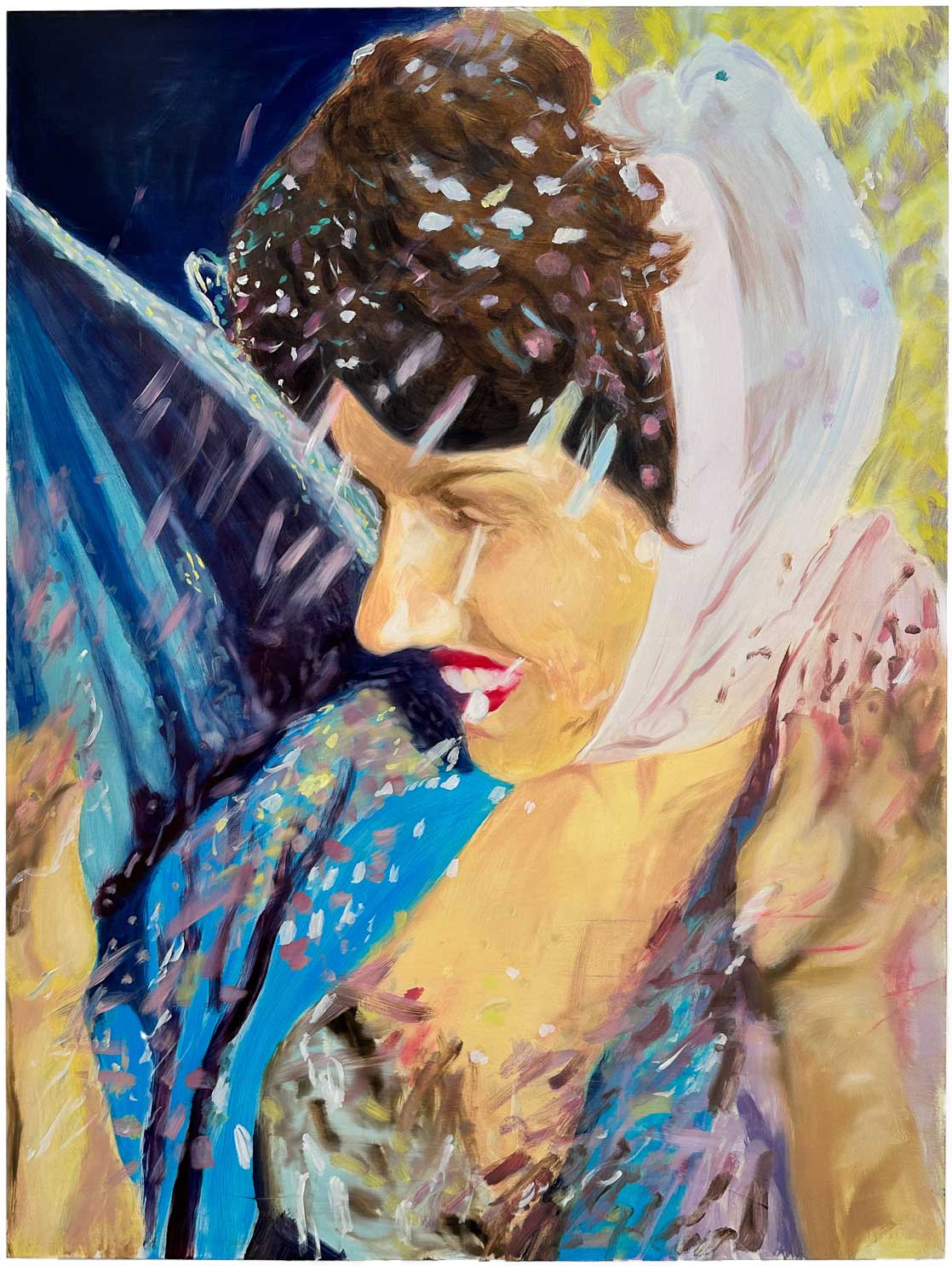Pleasure’s real or is it fantasy?
“Our senses are unendingly intricate and subtle. We can see, we can hear, we can touch and be touched, we can taste, we can smell. We know where the parts of our bodies are, we can feel hot and cold, we can feel pain, we can maintain our balance… We can find… those moments of complexity and complication that shake us awake and bind us ever more closely to life, those embodied and neurological experiences that reassure us that we are not alone.” Teju Cole.
The first thing that struck me, when I saw Maggie’s new work in her studio, were the colours. Primaries; Blue, the ocean; Yellow, the sand; Red, a flower blooming. Secondary pinks and oranges, lilacs and browns give the palette of a box of crayons, somehow carnivalesque, ecstatic. I looked around at the paintings, I was captured by their flash, my eyes adjusted, something clicked. I felt that I knew what I was looking at, but couldn’t quite yet understand it and I have been compelled to unravel it ever since.
The artist is my sister, and perhaps there is some kind of coded, unspoken language understood between siblings that leads me to that click of connection. But I suspect that I am not alone. Since I play a role in her life, and since I was recently visiting her after 2 years away, I have been lucky to experience the full tour of her world and studio and to spend time with the work she has made in this intimate context.
Looking at my sister’s studio across the back garden from her kitchen, I immediately wanted to sneak in and discover its secrets, like reading her diary if her diary was architecture, interior, light and landscape. It’s a funny compulsion to relish in that which we find mysterious but simultaneously long to demystify it. But here I go, trying to pull back the curtain, because I can’t help myself.
In my real life, my work is as a photographer, not a writer. Maggie’s work, for me, opens up a realm outside of reality, moving somewhere toward fantasy. So teetering on the edge I am attempting a new role of interpreter and interloper – in her reality, her fantasy, and now her text as well.
Maggie’s home is in Myponga, South Australia, the traditional home of the Kaurna people. On the South Australian Government’s website, it is acknowledged that British colonialism largely decimated the Kaurna people, their language, and their culture. In recent decades, extensive archival research is said to be leading to a revival of that language and culture. Today, Myponga is part of what is known as the Fleurieu Peninsula. It’s a big sky kind of place, and a big blue sky at that. Farmland rolls right into the sea. Yellows and greens bleached out and wild, meet turquoise and cerulean, and it’s not like anywhere else I’ve seen. There are whispers of certain stretches of the Mediterranean; like the coast of southern Albania, where the mountains hit the sea in a similar way in my memory, and rolling hills spotted with cattle always hint to me of England, where I live. But what I am most struck by is a sense of space, light, and vastness that applies to not only geography but time as well.
In the brightness of the sunshine and from the window of the car as we went driving around, the landscape came in flickers and blinks, and the image I formed was sort of like a screenshot. A single frame taken from a moving image. I have taken these impressions out of context to make meanings and associations out of them. I’ve had to. Otherwise it’s all too big and sweeping and grand; a sublime landscape. Its beauty is too monstrous to describe. It has to be experienced physically, or it has to be broken down and consumed in smaller pieces.
Now that I have left and taken these impressions with me, I run the risk of misremembering things. I have only my fragments and screenshots. I think that there is something impressionistic about Maggie’s work. The memory of something she saw out of the corner of her eye, or on someone else’s laptop screen, or at the supermarket, perhaps; A pair of white gloves, hovering above the dark soil, behind a fence, at dusk; a woman’s sandal, skinny jeans, walking by, afternoon. They are a bit like candid photographs, with a few details taken out, moved around or lost in motion. There is something documentary about them, but surreal and shadowy as well.
The paintings are figurative, depicting identifiable objects, actions and landscapes. But are they real, or are they fantasy? The arms and limbs of long-distance swimmers appear and disappear above and below the water, moving towards a boat. But where did they come from, the depths? Will they be swimming forever?
There is a painting in the European wing of the Art Gallery of New South Wales, that Maggie and I visited regularly when we both lived in Sydney around 15 years ago, so my memory of it might also be a little skewed. In the painting, there are 2 young men adrift on a raft in a pale blue sea. It looks like it’s cold and early morning. The men have pained expressions, but something about the bed that they lie on is soft and appealing. From memory, the story, as explained in the curatorial text, is that the young men had been exiled, their Achilles heels had been cut, and they had been sent out to sea with little hope of survival. But I think the story had a happy ending, and the men found some new life and redemption.
At the time, I never tried to understand why I loved this painting and wanted to visit it over and over. I just did. I don’t think it was about the narrative specifically, though; it was about the blue space, the bed, fraternity (sorority), melancholy, and a fantasy of Europe. I remembered it when I saw Maggie’s painting of the long-distance swimmers. I wonder if she remembers the raft as well?
What I see might be different to what Maggie saw or meant to say about it. But I am beginning to think that the space for misinterpretation or mistranslation might be entirely deliberate, or even the whole point. That’s the fantasy. That something might be allowed to mean something else, that things might change, progress, end up somewhere new. Or, like a Freudian slip, they tell us something true, even if they didn’t mean to.
To help refresh my memory when it came to writing this text, I took some pictures of the work in the studio. It was a very simple exercise to document the paintings, textiles (even though they were folded up and obscured at the time), and various little things around the studio that caught my eye. Mostly, I took one or two frames of each work, just to have an index. But when I reviewed the images, I realised that I had photographed a few of the paintings up to 14 times. But why? In part it was to ensure that the colours and exposure were correct. But more than this, it was because taking pictures has always been my way to attempt to understand, to pull myself closer to a subject, to find my way in.
One of the paintings that I documented many times is a self-portrait. But now I think of it as a picture of me as well. A woman is eating an ice cream. Licking it. Her eyes are closed, an expression of ecstasy on her face. It made me laugh a little nervous giggle, uncontrolled. In her book Animal Joy, poet and psychoanalyst Nuar Alisdair suggests that “we leak truths from our bodies all the time”, and I think that my laughter was my embarrassment leaking out of me. I felt self-conscious, looking at this moment of pleasure. It felt too intimate and too real. Of course, I enjoyed it at the same time.
Alisdair explains that laughter “imparts erotic, non-rational knowledge.” Through reading her essay, I am better able to interpret my own response. I was not simply laughing at the surface of the painting – my sister enjoying an ice cream. I was laughing at the sensations that the painting carries with it. Alisdair quotes Kierkegaard: “The essence of pleasure does not lie in the thing enjoyed, but in the accompanying consciousness”. It was not enough for me to simply be a spectator; I had to feel it as well, to share the sensation. The painting calls for it. The suite of paintings call for it, I think. They invite more connection with our true, unedited selves. That’s what happens when we dissolve a little bit of the facade of reality and melt a little way into fantasy. This simple pleasure is so huge, if I allow it. The cold, sweet ice cream on my tongue, a warm breeze, and all the places it takes me.
I have been reading, and re-reading Audre Lorde’s essay, Uses of the Erotic: The Erotic as Power. She describes the sensual as “those physical, emotional and psychic expressions of what is deepest and strongest and richest within all of us, being shared”. I am grateful for the sensuality of my sister’s work; a soft haze of longing, barely contained glee, budding, blooming.
During my visit to South Australia, we drove to a garden centre to buy some plants. It was closed when we arrived, but the drive was nice; along the coast, through the hills, into a forest. What magical spaces to traverse, and how funny to find a garden centre in a forest. Two opposing ideas of nature and growth intersecting – one of control, one of wild abandon. I was really struck by this during my visit. I felt like I was zooming in and out of realities. A fantastical world of ancient landscapes and histories and mundane suburban realities like buying mulch for a garden bed, laying pavers in the yard, a child’s play castle, reading stories to my niece; The Magic Beach – the picture book and the magical beach itself – just over the hill a short drive away, where two lovers have abandoned their towels and wandered off into the trees, and red dolphins leap from the waves.
I’ve always thought of it as a superpower of my sisters, to faithfully translate the world as it comes to her. To describe the way it feels. Thinking about her work as a sort of psychological documentary again, the seeming flatness of the painted surfaces are like printed photographs, CMYK and RGB streaking the page. In one painting, there is only R and a little B. It fits. Girls perform a pagan ritual in red. Primal and primary. I imagine myself in the performance.
Maggie has had an interest in paganism, ritual, and mythology since adolescence. She is true to what she loves and needs to express, and I think that some idea of faith, a primal knowing without the requirement of proof, is important to her work. Maggie has been looking at and painting Botticelli figures since we were teenagers. Again and again, repeating the 3 graces in oils and acrylics. This ritual of hers began the last time we lived in the suburbs when we pinned up posters ripped from magazines on our bedroom walls and taught ourselves to escape through imagery; perfume advertisements, movie posters, postcards from museums.
I was happy to see a Botticelli angel pinned up in streaked ink above her desk, next to a printed screenshot of the nun, sister Wendy, perhaps mid-way through explaining the violent origin story of rage and castration that brought Venus to life. There is a lot to see and to read when we look at a painting like this – in a museum or in reproduction – a lot of history, ideology, omission, and violence if we choose to see it. If not, there is still a lot of beauty and mastery.
Reading a painting can be a psychological exercise. A trip through our own memories and neuroses. Maybe we get the whole thing wrong or miss something important. But it doesn’t really matter. Just like it’s not important that you know these things about Maggie and what she loves or is faithful to. It’s only important that she keeps her faith and can continue to translate the world, from her backyard. That she has a garden to tend and stories to read. It doesn’t matter if it’s real or fantasy. Only that it exists.
—Benedict Brink, 2024
View Pleasure’s real or is it fantasy? the text and photo essay by Benedict Brink here
Maggie Brink’s paintings —layered and ghost-like representations of inanimate objects, landscapes and figures— are exhibited alongside sculptural works and textiles that are dyed, printed and sewn in different ways, sometimes with graphic imagery or text overlaid.
Transforming her references— tv shows, cinema and theatre, slogans, generic branding, (pseudo/) science, popular culture, history and mythology and a growing archive of her photographs and found images —through these constructed environments, Maggie creates and explores subtle and awkward exchanges — trading in subjective associative responses to produce open-ended and multiple meanings through her work.
An ongoing interest in Maggie’s practice is the way that exchange—with oneself, between oneself and other/s, with the world—and the reading and negotiation of images, texts, environments, other bodies — necessitates awareness and negotiation of boundaries: psychic, spiritual, physical, porous.
In 2021, Maggie relocated from Melbourne to Kaurna land, Myponga, South Australia, with her partner and daughter, where she built and set up a new studio in her backyard. Since then, she has been working on a series of paintings and textiles in preparation for her third solo exhibition with ReadingRoom, EURO FANTASY SHOWER CURTAIN. Benedict Brink has contributed a text and photo essay that accompanies the exhibition.
Maggie Brink (b. 1983, Brisbane, Australia) currently lives and works in Kaurna land, South Australia. She received her MFA(2020) from Sydney College of the Arts, where she also completed a Bachelor of Visual Arts (Honours) in 2014. She has participated in numerous group exhibitions in Australia and New Zealand, and solo exhibitions include Metal Rat Mystery Horse, ReadingRoom, Melbourne (2021), Alien Alien Crocodile Shadow, ReadingRoom, Melbourne (2018), Pale Blue Dot Dot Dot, Firstdraft, Sydney (2017), County Athletics, Knulp, Sydney (2017). Maggie will attend the DESA Artist-In-Residence program, hosted in Bali, Indonesia, in mid-2024.

